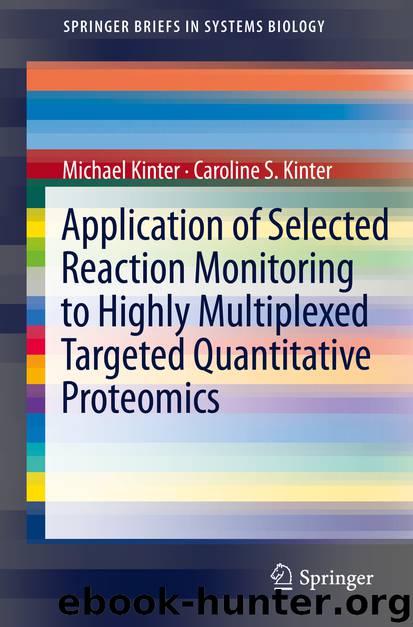Application of Selected Reaction Monitoring to Highly Multiplexed Targeted Quantitative Proteomics by Michael Kinter & Caroline S. Kinter

Author:Michael Kinter & Caroline S. Kinter
Language: eng
Format: epub
Publisher: Springer New York, New York, NY
(6) Validate and test the final descriptor
The final step in the development process involves asking two key questions about how the descriptor is working. Does the descriptor detect the peptides it is designed to detect? How does the descriptor function in the samples that will be analyzed?
The first question is a validation question and is particularly important when the design process begins with information obtained from a database like the PeptideAtlas. Careful skepticism is needed to evaluate the detection of these peptides and specifically the retention time, the CID spectrum, and the apparent abundance of each peptide. Throughout the design process, peptides that elute at times that are consistent with their calculated hydrophobicity are preferred and, in the case of ACOX1 one peptide was excluded because of this issue. It is also possible to compare pseudo CID spectra, reconstructed from the selected reaction monitoring data, with reference spectra obtained from the database. This process is shown in Fig. 3.6. For each peptide, the comparison focuses on the y-ion series because of differences in the b-ion series expected in a triple quadrupole instrument relative to the ion trap and orbitrap instrument that produce most of the data in the database. In all three peptides, strikingly similar spectra are seen even with the lack of the low m/z y1-ions and the ions lost to the excitation pulse in the ion trap instrument. As a final stage, the BioGPS data are consistent with ACOX1 being significantly more abundant in the liver than in the heart or skeletal muscle and these differences are seen in the LC-tandem mass spectrometry analysis. Additional analyses of sample types that would not contain the specific mouse ACOX1 peptides would also be useful. These samples could come from other mammalian systems or more distant systems such as yeast if available.
Fig. 3.6A comparison of CID spectra as a part of the verification process. The top spectrum for each is reconstructed based on the abundance of the y-ion series recorded in a selected reaction monitoring experiment. The bottom spectrum for each is a representative reference spectrum containing only the y-ions downloaded from the PeptideAtlas. Since these spectra were recorded with an ion trap instrument, the blue arrow designate fragment ions that are lost due to the excitation pulse. Further, the low mass cutoff for each left out the y1-ions at m/z 147
Download
This site does not store any files on its server. We only index and link to content provided by other sites. Please contact the content providers to delete copyright contents if any and email us, we'll remove relevant links or contents immediately.
| Automotive | Engineering |
| Transportation |
Whiskies Galore by Ian Buxton(41879)
Introduction to Aircraft Design (Cambridge Aerospace Series) by John P. Fielding(33064)
Small Unmanned Fixed-wing Aircraft Design by Andrew J. Keane Andras Sobester James P. Scanlan & András Sóbester & James P. Scanlan(32743)
Craft Beer for the Homebrewer by Michael Agnew(18140)
Turbulence by E. J. Noyes(7936)
The Complete Stick Figure Physics Tutorials by Allen Sarah(7307)
Kaplan MCAT General Chemistry Review by Kaplan(6867)
The Thirst by Nesbo Jo(6826)
Bad Blood by John Carreyrou(6552)
Modelling of Convective Heat and Mass Transfer in Rotating Flows by Igor V. Shevchuk(6391)
Learning SQL by Alan Beaulieu(6211)
Weapons of Math Destruction by Cathy O'Neil(6143)
Man-made Catastrophes and Risk Information Concealment by Dmitry Chernov & Didier Sornette(5921)
Digital Minimalism by Cal Newport;(5664)
Life 3.0: Being Human in the Age of Artificial Intelligence by Tegmark Max(5474)
iGen by Jean M. Twenge(5366)
Secrets of Antigravity Propulsion: Tesla, UFOs, and Classified Aerospace Technology by Ph.D. Paul A. Laviolette(5309)
Design of Trajectory Optimization Approach for Space Maneuver Vehicle Skip Entry Problems by Runqi Chai & Al Savvaris & Antonios Tsourdos & Senchun Chai(5011)
Pale Blue Dot by Carl Sagan(4912)
